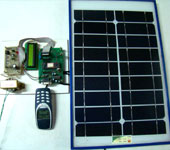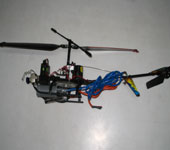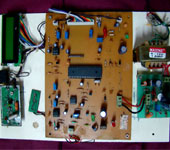Fire alarm circuit
Fire alarm circuit
Fire alarm circuit
Description.
Here is a simple fire alarm circuit based on a LDR and lamp pair for sensing the fire.The alarm works by sensing the smoke produced during fire.The circuit produces an audible alarm when the fire breaks out with smoke.
When there is no smoke the light from the bulb will be directly falling on the LDR.The LDR resistance will be low and so the voltage across it (below .6V).The transistor will be OFF and nothing happens.When there is sufficient smoke to mask the light from falling on LDR, the LDR resistance increases and so do the voltage across it.Now the transistor will switch to ON.This gives power to the IC1 and it outputs 5V.This powers the tone generator IC UM66 (IC2) to play a music.This music will be amplified by IC3 (TDA 2002) to drive the speaker.
The diode D1 and D2 in combination drops 1.4 V to give the rated voltage (3.5V ) to UM66 .UM 66 cannot withstand more than 4V.
Circuit diagram with Parts list.
Notes.
- The speaker can be a 8Ω tweeter.
- POT R4 can be used to adjust the sensitivity of the alarm.
- POT R3 can be used for varying the volume of the alarm.
- Any general purpose NPN transistor(like BC548,BC148,2N222) can be used for Q1.
- The circuit can be powered from a 9V battery or a 9V DC power supply.
- Instead of bulb you can use a bright LED with a 1K resistor series to it.
www.indianengineer.wordpress.com
www.indianengineer.wordpress.com
email Us at
Freshersblog@gmail.com
Long Range FM Transmitter 1
Long Range FM Transmitter 1
Long Range FM Transmitter 1
How to make a long range FM transmitter at low cost
Description
The use of transmitters which have a more powerful output than the ‘flea-power’ are sometimes required when there are many obstacles in the path of the surveillance transmitter and monitoring station receiver, or the distance between them is too far so as to make a low powered device feasible. Whereas a typical microtransmitter will produce an RF power in the order of just a few milliwatts, i.e. a few thousandths of a watt, the VHF-FM transmitter described has a power output of between around a half and 2 watts, depending on the power source, which may be anywhere between 6 volts and 30 volts d.c. The battery or batteries should be of the alkaline high power type, since the current drain will be found to be relatively higher when compared to microtransmitter current drain. The power output of this device is somewhat proportional to the current drain and so therefore both may be decreased by altering the value of R6 to a higher resistance, or a variable resistor with a value of around 1k may be introduced in series with the existing R6, so as to give a variable power output. The variable resistor must not be a wirewound device because this would act as an inductor which will cause feedback problems.The audio input to the power oscillator, which incidentally is formed by TR2 and associated components, is derived from a piezoelectric microphone which drives the simple audio frequency amplifier TR1. The input of the audio amplifier is controlled by the gain pot R1, which selects the correct amount of voltage that is generated by the piezoelectric microphone, then connects this signal to the base of audio amplifier TR1 via C7. It may be found that there is insufficient housing space for a bulky piezoelectric microphone, so with a slight modification to the circuit, it is possible to employ an electret microphone insert as shown. Since the RF field that is generated by this transmitter is relatively large, the problem of RF feedback may very well be encountered. This may be overcome by placing the transmitter inside a metal enclosure, keeping all internal wiring as short as possible and the aerial wire.
Component listing for 1 watt transmitter
Resistors Semiconductors R1 = 27k TR1 = BC547 R2 = 330k TR2 = 2N2219 fitted with heatsink R3 = 5k6 MIC = piezoelectric microphone R4, 5 = 10k R6 = 100R
L = 6 turns 22 gauge enamelled wire wound on 3⁄16″ former
Capacitors
C1, 2, 3, 8 = 330 pF C4 = 2–10 pF trimmer C5 = 4p7 C6 = 1 nF
C7,C8 = 40uF/25V Electrolytic
Circuit diagram for Long range FM Transmitter
www.indianengineer.wordpress.com
www.indianengineer.wordpress.com
email Us at
Freshersblog@gmail.com
150 Watt amplifier circuit
150 Watt amplifier circuit
Description
This is the cheapest 150 Watt amplifier circuit you can get,I think.Based on two Darlington power transistors TIP 142 and TIP 147 ,this circuit can deliver a blasting 150 W Rms to a 4 Ohm speaker.Enough for you to get rocked?,then try out this.
TIP 147 and 142 are complementary Darlington pair transistors which can handle 5 A current and 100V ,famous for their ruggedness. Here two BC 558 transistorsQ5 and Q6 are wired as pre amplifier and TIP 142 ,TIP 147 together with TIP42 (Q1,Q2,Q3) for driving the transistors.This circuit is designed so rugged that this can be assembled even on a common board or even by pin to pin soldering.The circuit can be powered from a +/-45V 5A dual power supply.You must try this circuit.Its working great.
Circuit Diagram & Parts List .
Notes.
- Remember TIP 142 and 147 are Darlington pairs .They are shown as conventional transistors in figure for ease.So don’t get confused.Even though each of them have 2 transistors ,2 resistors and 1 diode inside ,only three pins ,base emitter and collector are coming out.Rest are connected internally.So its quite OK to assume each of them as transistor for ease.
- Use a well regulated and filtered power supply.
- Connect a 10K POT in series with the input as volume control if you need.Not shown in circuit diagram.
TIP 142 & 147 Internal diagram and pin out.
www.indianengineer.wordpress.com
www.indianengineer.wordpress.com
email Us at
Freshersblog@gmail.com
100 Watt inverter circuit
100 Watt inverter circuit
100 Watt inverter circuit
Description
Here is a 100 Watt inverter circuit using minimum number of components.I think it is quite difficult to make a decent one like this with further less components.Here we use CD 4047 IC from Texas Instruments for generating the 100 Hz pulses and four 2N3055 transistors for driving the load.
The IC1 Cd4047 wired as an astable multivibrator produces two 180 degree out of phase 100 Hz pulse trains.These pulse trains are are preamplifes by the two TIP122 transistors.The out puts of the TIP 122 transistors are amplified by four 2N 3055 transistors (two transistors for each half cycle) to drive the inverter transformer.The 220V AC will be available at the secondary of the transformer.Nothing complex just the elementary inverter principle and the circuit works great for small loads like a few bulbs or fans.If you need just a low cost inverter in the region of 100 W,then this is the best.
Circuit Diagram with Parts List.
Notes.
- A 12 V car battery can be used as the 12V source.
- Use the POT R1 to set the output frequency to50Hz.
- For the transformer get a 9-0-9 V , 10A step down transformer.But here the 9-0-9 V winding will be the primary and 220V winding will be the secondary.
- If you could not get a 10A rated transformer , don’t worry a 5A one will be just enough. But the allowed out put power will be reduced to 60W.
- Use a 10 A fuse in series with the battery as shown in circuit.
- Mount the IC on an IC holder.
- Remember,this circuit is nothing when compared to advanced PWM inverters.This is a low cost circuit meant for low scale applications.
Design Tips.
The maximum allowed output power of an inverter depends on two factors.The maximum current rating of the transformer primary and the current rating of the driving transistors.
For example ,to get a 100 Watt output using 12 V car battery the primary current will be ~8A ,(100/12) because P=VxI.So the primary of transformer must be rated above 8A.
Also here ,each final driver transistors must be rated above 4A. Here two will be conducting parallel in each half cycle, so I=8/2 = 4A .
These are only rough calculations and enough for this circuit.
WWW.IndianEngineer.wordpress.com
Email FreshersBlog@gmail.com
Biggest Project Service Provider in Delhi
All Types of Projects for all Branches are Available
Remote toggle switch circuit
Remote toggle switch circuit
Remote toggle switch circuit
Description.
In application level this circuit is similar to that of the circuit given previously. The only difference is in the approach. This circuit is designed by using another method. Using this circuit you can toggle any electrical appliance between ON and OFF states by using your TV remote. The only requirement is that your TV remote should be operating in the 38 KHz.
The IC1 (TSOP 1738) is used to receive the infrared signals from the remote. When no IR signal from remote is falling on IC1, its output will be high. When the IR signal from the remote falls on the IC1, its output goes low. This triggers the IC2 which is wired as a monostable multivibrator.The output of the IC2 (pin6) goes high for a time of 1S (set by the values of R2 and C3.This triggers the flip flop (IC2) and its Q output (pin 15) goes high. This switches on the transistor, which activates the relay and the appliance connected via relay is switched ON. For the next press of remote the IC1 will be again triggered which in turn makes the IC2 to toggle its output to low state. The load will be switched OFF. This cycle continues for each press of the remote. The pin 6 and pin 4 of IC1 are shorted to avoid false triggering.The diode D1 can be used as a freewheeling diode.
Circuit diagram with Parts list.
Notes.
- Assemble the circuit on a good quality PCB or common board.
- The circuit can be powered from a 5V DC regulated power supply.
- The capacitors must be rated 15 V.
- The IC1&IC2 must be mounted on holders.
- The current capacity of relay determines the load circuit can switch.Use a high amperage(`10A or above) relay for driving large loads like motor,heater etc.
To Get this Project Contact Us or leave us an Email
At freshersblog@gmail.com.
or Call us at 9717408885
Remote controlled appliance switch circuit
Remote controlled appliance switch circuit
Description.
Here is a versatile remote controlled appliance switch that can ON or OFF any appliance connected to it using a TV remote.
IR remote sensor IC TSOP 1738 is used for recieving the signal. Normally when no signal is falling on IC3 the output of it will be high.This makes Q1 OFF.When a signal of 38 KHz from the TV remote falls on the IC3 its output goes low.This makes Q1 conduct and a negative pulse is obtained at pin 2 of IC 1 NE 555.Due to this IC1 wired as a monostable multivibrator produces a 4 Sec long high signal at its out put.This high out put is the clock for IC 2 which is wired as a Flipflop and of , its two outputs pin 3 goes low and pin 2 goes high.The high output at pin 2 is amplified to drive the relay .For the next signal the outputs of IC2 toggles state. Result, we get a relay toggling on each press on the remote.Any appliance connected to this circuit can be switched ON or OFF.
Circuit Diagram with Parts List .
Notes.
- Before wiring the circuit make sure that the carrier frequency of the TV remote you have is 38 KHz.For that wire the sensor part only ,point your remote to the TSOP1738 and press any switch.If out put of TSOP1738 goes low them ok, your remote is of 38Khz type.Nothing to worry almost all TV remote are of this type.
- You can use any switch because for any switch the code only changes,the carrier frequency remains same.We need this carrier frequency only.
- Assemble the circuit on a good quality PCB or common board.
- The appliance can be connected through NO or NC and contacts of the relay .
www.indianengineer.wordpress.com
email freshersblog@gmail.com
Go to contact us page to contact Us or leave us an email.
We Deals in Projects Kits,circuits,models,presentations,training kits,
Wanna Buy this projects call Us. 9717408885
Low cost projects only at indianEngineer’s


















 PROJECTS TO GET COSTLY as demand will increase as exams reach so HURRY to GET it on TIME
PROJECTS TO GET COSTLY as demand will increase as exams reach so HURRY to GET it on TIME





